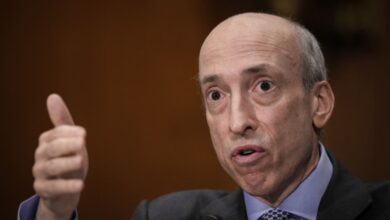Opinion: The U.S. economy needs older workers. Congress can help.

“Employment rates still lag for people 55 and over.”
More and more Americans previously relegated to the margins of the economy are successfully finding work. But for one group of workers, the jobs surge has been less dramatic — namely those aged 55 and over. Fortunately, Congress has a mechanism to help address this discrepancy — they just need to fund it.
Even as the employed share of “prime working age” Americans (25 to 54) has recovered to pre-pandemic levels — and in the case of women, now exceeds those levels — employment rates still lag for people 55 and over. At the same time, job vacancies in the U.S. economy still outnumber the count of people actively seeking work. Certain sectors have particularly high levels of vacancies, like healthcare, social services, child care and long-term care facilities.
Thankfully, Congress already has a way to help connect older workers who are on the sidelines of the labor market with available opportunities. The Senior Community Service Employment Program (SCSEP) is the only federal employment and training program geared specifically toward people 55 and older who want to work but face barriers to securing employment. Puzzlingly, House Republicans are proposing to pull the plug on this program at the worst possible time, just when older workers and the economy at large need it most.
Over the next decade, individuals 55 and older are predicted to drive 42% of U.S. labor-force growth, with women leading the way. In other words, future economic growth will hinge on older workers’ participation in the workforce. While the ranks of older workers have been growing for decades, many need a boost to help them find good jobs. Even people with steady work histories may need to upgrade their skills late in their careers to take advantage of new and developing job opportunities. People with breaks in their employment history may need even more help.
When older workers get laid off from a long-term job, data shows they’re substantially less likely to find new work than people under 55 and are at greater risk of withdrawing from the labor market entirely. Similarly, people who take time away from the workforce to attend to their own health needs or to care for a loved one often find jumping back into it no easy feat. Caregiving can weigh especially heavy on older women — in fact, it’s five times more likely to impact their employment than their same-age male peers.
This is where SCSEP comes in. The program serves people 55 and older who face specific barriers to employment. It provides on-the-job training and placement in jobs in community-service settings for unemployed people with incomes under 125% of the poverty line. The program subsidizes the wages paid to program participants, so that the community service providers benefit from the program as well. Subsidized employment in SCSEP is designed as a temporary stepping stone to help people facing the steepest employment barriers transition from unemployment to regular employment and enjoy the economic security that comes along with it.
“Wages earned by these older workers cycle back into local economies.”
For years, annual funding for SCSEP has only been able to serve a fraction of those eligible — less than 1%. Sadly, funding has failed to keep pace with increasing wages and an increasing older population. Enrollment for program year 2023 is estimated at 42,281 individuals. Priority is given to veterans, people with disabilities, people 65 and older, people living in rural areas, people with limited English proficiency or low-literacy skills, and people with other barriers to employment. About two-thirds of all participants are women, a similar proportion are members of a racial or ethnic minority, and more than one in four have at least one disability. Beyond the employment-related benefits of the program, a recent study found that it also promotes better financial, physical, mental and social well-being among participants.
Communities across the country stand to benefit from SCSEP, as program participants train and work in schools, daycares, hospitals, senior centers and similar settings experiencing high job-vacancy rates. These public and non-profit workplaces benefited from more than 21 million hours of work from SCSEP participants in 2019. What’s more, the wages earned by these older workers cycle back into local economies as they’re spent on necessities like food, rent, healthcare and transportation.
Zeroing out funding for SCSEP — as proposed in the House budget — would mean shutting down one of the few pipelines to employment available for tens of thousands of older, low-income individuals who both want and need to work. It would also stomp out the profound economic benefits SCSEP provides to local non-profit and public entities and the communities they serve. With the job market on a tear, our economy needs programs like this now more than ever in order to ensure the benefits of our robust job growth are felt equally, regardless of age.
Beth Almeida is a senior fellow with the Women’s Initiative and Veronica Goodman is the senior director for workforce development policy for the Education Department at the Center for American Progress.
Also read: Fed officials more worried about cutting rates too fast than moving too slow, minutes show
More: Forget the billions. How much will climate change really cost your family?
Source link





